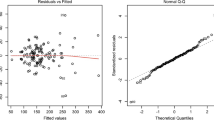Abstract
A genetic model for modified diallel crosses is proposed for estimating variance and covariance components of cytoplasmic, maternal additive and dominance effects, as well as direct additive and dominance effects. Monte Carlo simulations were conducted to compare the efficiencies of minimum norm quadratic unbiased estimation (MINQUE) methods. For both balanced and unbalanced mating designs, MINQUE (0/1), which has 0 for all the prior covariances and 1 for all the prior variances, has similar efficiency to MINQUE(θ), which has parameter values for the prior values. Unbiased estimates of variance and covariance components and their sampling variances could be obtained with MINQUE(0/1) and jackknifing. A t-test following jackknifing is applicable to test hypotheses for zero variance and covariance components. The genetic model is robust for estimating variance and covariance components under several situations of no specific effects. A MINQUE(0/1) procedure is suggested for unbiased estimation of covariance components between two traits with equal design matrices. Methods of unbiased prediction for random genetic effects are discussed. A linear unbiased prediction (LUP) method is shown to be efficient for the genetic model. An example is given for a demonstration of estimating variance and covariance components and predicting genetic effects.
Similar content being viewed by others
References
Beavis WD, Pollak E, Frey KJ (1987) A theoretical model for quantitatively inherited traits influenced by nuclear-cytoplasmic interactions. Theor Appl Genet 74:571–578
Cockerham CC (1980) Random and fixed effects in plant genetics. Theor Appl Genet 56:119–131
Cockerham CC, Weir BS (1977) Quadratic analyses of reciprocal crosses. Biometrics 33:187–203
Dani RG, Kohel RJ (1989) Maternal effects and generation mean analysis of seed-oil content in cotton (Gossypium hirsutum L.) Theor Appl Genet 77:569–575
Efron B (1982) The jackknife, the bootstrap and other resampling plans. Society for Industrial and Applied Mathematics, Philadelphia, Pa.
Eisen EJ, Hörstgen-Schwark G, Saxton AM, Bandy TR (1983) Genetic interpretation and analysis of diallel crosses with animals. Theor Appl Genet 65:17–23
Foolad MR, Jones RA (1992) Models to estimate maternally controlled genetic variation in quantitative seed characters. Theor Appl Genet 83:360–366
Gardner CO, Eberhart SA (1966) Analysis and interpretation of the variety cross diallel and related populations. Biometrics 22:439–452
Giesbrecht FG (1985) MIXMOD: A SAS procedure for analysing mixed models. Mimeo series No. 1659. Institute of Statistics, North Carolina State University, Raleigh, N.C.
Gowe RS, Fairfull RW (1982) Heterosis in egg-type chickens. In: 2nd World Congr Genet Appl Livestock Production 6:228–242, Madrid
Griffing B (1956) Concept of general and specific combining ability in relation to diallel crossing systems. Aust J Biol Sci 9:463–493
Hartley HD, Rao JNK (1967) Maximum-likelihood estimation for the mixed analysis of variance model. Biometrika 54:93–108
Henderson CR (1948) Estimation of general, specific and maternal combining abilities in crosses among inbred lines of swine. PhD thesis, Iowa State University, Ames, Iowa
Henderson CR (1963) Selection index and expected genetic advance. In: Hanson WD, Robinson HF (eds) Statistical genetics and plant breeding. Natl Acad Sci, NRC 982, pp 141–163
Henderson CR (1979) Using estimates in predictions of breeding values under a selection model. In: Van Vleck LD, Searle SR (eds) Variance components and animal breeding. Cornell University, Ithaca, N.Y., pp 217–227
Keele JW, Harvey WR (1989) Estimation of components of variance and covariance by symmetric differences squared and minimum norm quadratic unbiased estimation: a comparison. J Anim Sci 67:348–356
Kinderman AJ, Monahan JF (1977) Computer generation of random variables using the ratio of normal deviates. Assoc Comput Mach Trans Math Soft 3:257–260
Mather K, Jinks JL (1982) Biometrical genetics, 3rd edn. Chapman and Hall, London
Miller RG (1974) The jackknife — a review. Biometrika 61:1–15
Mosjidis JA, Yermanos DM (1984) Maternal effects and cytoplasmic inheritance of oleic and linoleic acid contents in sesame. Euphytica 33:427–432
Patterson HD, Thompson R (1971) Recovery of inter-block information when block sizes are unequal. Biometrika 58:545–554
Quaas RL, Pollak EJ (1980) Mixed model methodology for farm and ranch beef cattle testing programs. J Anim Sci 51:1277
Rao CR (1970) Estimation of heteroscedastic variances in linear models. J Am Stat Assoc 65:161–172
Rao CR (1971) Estimation of variance and covariance components MINQUE theory. J Multivar Anal 1:257–275
Rao CR (1972) Estimation of variance and covariance components in linear models. J Am Stat Assoc 67:112–115
Rao CR, Kleffe J (1980) Estimation of variance components. In: Krishraiah PR (ed) Handbook of statistics, vol 1. North-Holland Publ, New York, pp 1–40
Searle SR, Casella G, McCulloch CE (1992) Variance components. Wiley, New York
Swallow WH, Monahan JF (1984) Monte Carlo comparison of ANOVA, MINQUE, REML and ML estimators of variance components. Technometrics 6:47–57
Tan NY, Shiue WW (1982) Comparative studies on the estimation of genetic variances by several variance component estimation methods. Biometrical J 24:543–557
Topham PB (1966) Diallel analysis involving maternal and maternal interaction effects. Heredity 21:665–674
Vencovsky R (1970) Alguns aspectors teóricos e aplicodos relativos a cruzamentos dialelicos de variedades. Tese de Livre-Docencia, ESALQ-USP, Piracicaba, Brazil
Willham RL (1963) The covariance between relatives for characters composed of components contributed by related individuals. Biometrics 19:18–27
Author information
Authors and Affiliations
Additional information
Communicated by A. L. Kahler
Rights and permissions
About this article
Cite this article
Zhu, J., Weir, B.S. Analysis of cytoplasmic and maternal effects I. A genetic model for diploid plant seeds and animals. Theoret. Appl. Genetics 89, 153–159 (1994). https://doi.org/10.1007/BF00225135
Received:
Accepted:
Issue Date:
DOI: https://doi.org/10.1007/BF00225135




